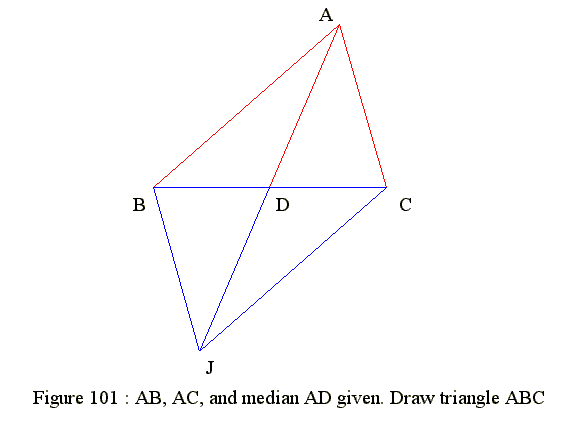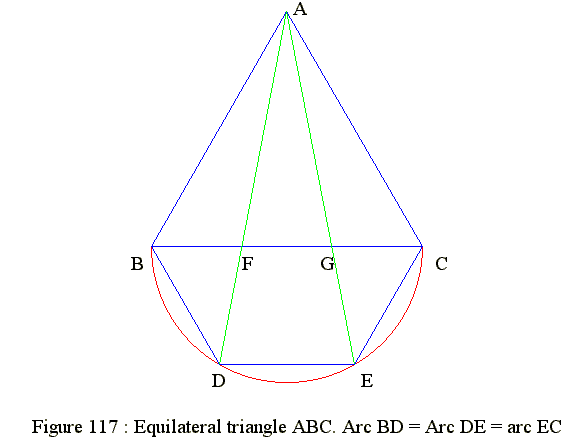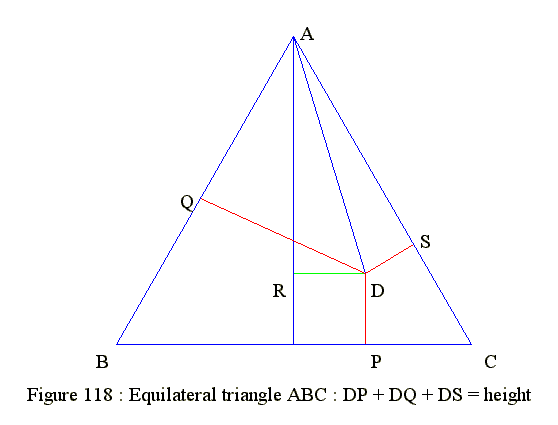-
Symbol Defintion
Sqr(x) = Square root of x
GE 27 01. Construct triangle if b,c and median AD are given
Given
- Triangle ABC : AB = c = 10, CA = b = 6 and median AD = m1 = 7
- Construct triangle ABC
- Draw triangle ACJ
- AC = b, CJ = c and AJ = 2*m1
- Since 3 sides are known hence we can draw triangle ACJ
- Let D be mid point of AJ
- Join CD and produce CD to B. Let BD = DC
- Join AB and triangle ABC is the required angle
- Since BC and AJ bisect each other, hence ACBJ is a parallelogram
- Then AB = CJ = c
- AC = b by construction
- AD = AJ/2 = m1 by construction
- Hence triangle ABC is the required triangle

Go to Begin
GE 27 02. Triangle ABC : median AD = m1, medina BE = m2 and AB = c are given
Given
- Median AD = 14, BE = 27 and c = 27
- Construct triangle ABC
- Let G be the gravity center of triangle ABC
- Let AG = 2*m1/3, BG = 2*m2/3 and AB = c
- Then 3 sides of triangle ABG are known, hence we can construct ABG
- Produce BG to E and let EG = BG/2
- Produce AG to D and let GD = AG/2
- Line AE and line BD meet a point C
- Triangle ABC is the required triangle
- Based on G is the gravity center

Go to Begin
GE 27 03. Circle : Three corcles touch each other with common tangent
Diagram

- Three circles as shown in Figure 103
- Circle A has radius a
- Circle B has radius b
- Circle C has radius c
- Find the length of common tangent RT in terms of a and b
- Find the radius c interms of a and b
- In right triangle ABD
- AB = a + b
- AD = a - b
- By Pythagorean law, we have BD^2 = AB^2 - AD^2
- Hence BD^2 = (a + b)^2 - (a + b)^2 = 4*a*b
- Hence RT = BD = 2*Sqr(a*b)
- Find radius c of circle C
- Common tangent of circle A and C is RS = 2*Sqr(a*c)
- Common tangent of circle B and C is ST = 2*Sqr(b*c)
- Since RT = RS + ST
- Hence 2*Sqr(a*b) = 2*Sqr(a*c) + 2*Sqr(b*c)
- Simplified we have Sqr(c) = Sqr(a*b)/(Sqr(a) + Sqr(b))
- Hence c = (a*b)/(a + b + 2*Sqr(a*b))
Go to Begin
GE 27 04. Square with 4 semi-circle
Diagram

- Square with side = a
- Use center of each side draw semi-circles with radius = a/2
- Find the shaded area as shown in Figure 104
- The common area of the four semi-circles is 4*(area of semi-circle) - area of square
- Hence common area = 4*((pi*r^2)/2) - a^2 = 2*pi*(a^2/4) - a^2 = (pi/2 - 1)*a^2
Go to Begin
GE 27 05. Circle inscribed an equilateral triangle
Diagram

- As shown in Figure 105, find the area of the smallest circle
- Let side of equilateral tiangle be a
- Height of equilateral triangle ABC is h = Sqr(3)*a/2
- Hence large circle radius is r1 = h/3
- The 2nd large circle radius is r2 = r1/3 = (h/3)/3 = h/(3^2)
- The 3rd large circle radius is r3 = r2/3 = h/(3^3)
- Hence r3 = (0.5*Sqr(3)*a)/27
- Hence area of small circle = pi*(r3)^2
Go to Begin
GE 27 06. Circle inscribed an equilateral triangle
Diagram

- 1. Find the total area of the small circles as shown in Figure 106
- 2. Find the ratio of area of triangle and the total area of circles
- Let side of equilateral tiangle be a
- Height of equilateral triangle ABC is h = Sqr(3)*a/2
- Hence large circle radius is r1 = h/3
- The 2nd large circle radius is r2 = r1/3 = (h/3)/3 = h/(3^2)
- Hence area of 3 small circle is
- Area = 3*pi*(r2)^2
- Area = 3*pi*(h/9)^2
- Area = 3*pi*(1.5*Sqr(3)/9)^2
- Area of triangle = a*(a*Sqr(3)/2)/2 = (Sqr(3)*a^2)/4
- Area of circles = pi*(r1)^2 + 3*pi*(r2)^2
- r1 = h/3 = Sqr(3)*a/6
- r2 = h/9 = Sqr(3)*a/18
- Hence ratio = ?
Go to Begin
GE 27 07. Square inscribed an equilateral triangle
Diagram

- As shown Figure 107 find ratio of area of equilateral triangle to square
- Let side of square be a
- Triangle PQC is also equilateral triangle
- Hence height CE = Sqr(3)*a/2
- Hence height CD = CE + ED = a*(1 + Sqr(3)/2)
- AB = AS + SR + RB = 2*AS + a
- Since triangle ASP similar to PEC, hence AS/PE = PS/CE
- Hence AS = PS*PE/CE = a/Sqr(3)
- Hence AB = 2*a/Sqr(3) + a = a*(1 + 2/Sqr(3))
- Hence area of triangle ABC = AB*CD/2
- = (a^2)*(1 + Sqr(3)/2)*(1 + 2/Sqr(3))/2
- = (a^2)*(1 +7*Sqr(3)/12)
- Ratio of ABC : PQRS = (1 + 7*Sqr(3)/12) : 1
Go to Begin
GE 27 08. Triangle : Area of triangle formed by medians
Diagram

- As shown Figure 108, AD, BE and CF are medians of triangle ABC
- Use AD, BE, CF making a triangle PQR
- Find ratio of area triangle PQR to area of triangle ABC
- Let AG = 2*AD/3, AH = 2*BE/3 and GH = 2*CF/3
- Construct triangle AGH
- Area of triangle AGH
- Let height of triangle ABC from C is h
- Height of triangle AFG is h/3
- Height of triangle AHF is also h/3
- Area of triangle AGH = area AGF + area AHF
- = (AB/2)*(h/3)/2 + (AB/2)*(h/3)/2
- = (AB*h)/6
- = (area of triangle ABC)/3
- Triangle AGH and triangle PQR are similar
- (height of PQR)/(height of AGH) = 3/2
- (area of PQR)/(area of AGH) = (3/2)^2
- Hence area PQR = (9/4)*(area 0f AGH)
- = (9/4)*((area of triangle ABC)/3)
- = (3/4)*(area of triangle ABC)
- Hence (area of PQR) : (area of ABC) = 3 : 4
Go to Begin
GE 27 09. Equilateral triangle : Medians and heights
Diagram

- Median and height of equilateral triangle coincide
- Draw CF perpendicular to AB. Hence CF is the height
- Since CA = CB
- Hence CF bisects side AB and F is the mid-point of side AB
- Hence CF is also the median
- The in-center, circum center, gravity center and ortho-center coincide
- Three heights meet at O and it is the orthocenter
- Three medians meet at O and it is the graivty center
- CF is also the bisector of angle ACB
- Since triangle CAF is congruent to triangle CBF
- Hence angle AFC = angle BFC
- Hence CF is the bisector of angle ACB
- Similarly, AD and BE are also angle bisectors
- Hence O is the in-center
- OF is bisector of side AB
- Since OF perpendicualr to AB and AF = FB
- Hence OF is bisector of side AB
- Similarly, OD is bisector BC and OE is bisector of CA
- Hence O is the circum-center
- Find area of pedal triangle of equilateral triangle ABC
- Triangle DEF is the pedal triangle
- D and E are mid-points and DE = AB/2
- Similarly EF =BC/2 and FD = CA/2
- Hence Petal triangle DEF is equilateral
- Hence area of pedal triangle DEF is area ABC/4
Go to Begin
GE 27 10. Pedal triangle of equilateral triangle
Diagram

- Find area of pedal triangle of equilateral triangle ABC
- Triangle DEF is the pedal triangle
- D and E are mid-points and DE = AB/2
- Similarly EF =BC/2 and FD = CA/2
- Hence Petal triangle DEF is equilateral
- Hence area of pedal triangle DEF is area ABC/4
Go to Begin
GE 27 11. Ex-central triangle of equilateral triangle
Diagram

- Find area of ex-central triangle of equilateral triangle ABC
- Ex-centers
- Bisector of angle A and bisectors of two external angle meet at J
- It is the ex-center.
- Similarly, K and L are also ex-center
- J, C, K are colinear
- Angle JCB = (Ex-ternal angle C)/2
- Angle BCO = (angle C)/2
- Hence angle JCO is 90 degrees
- Similarly, angle KCO is 90 degrees
- Hence J, C, K are colinear
- K, A, L are also colinear
- L, B, J are also colinear
- Hence JKL make triangle with A, B, C on their sides
- Triangle JKL is call ex-central triangle
- Area of JCB = Area ABC
- Since JCB = JBC = 60 degrees
- Hence triangle JBC is equilateral triangle
- Similarly, KAC and LAB are equilateral triangle
- Hence area of JKL = 4*(area ABC)
Go to Begin
GE 27 12. Pedal triangle
Diagram

- 1. What is pedal triangle ?
- 2. AD is the bisector of angle EDF
- 3. Ortho-center of triangle ABC is the in-center of triangle DEF
- 4. Triangle ABC is the ex-central triangle of triangle DEF
-
Pedal Triangle
Text
Go to Begin
GE 27 13. Ex-central triangle
Diagram

- 1. What is ex-central triangle ?
- 2. Center of circle J is ex-circle between line AB and AC
- 3. J, C, K are colinear
- JC is bisector of external aangle of angle ACB
- LC is bisector of angle ACB
- Hence angle LCJ is 90 degrees
- Similarly, angle LCK is 90 degrees
- Hence J, C, K are colinear
- 4. CL perpendicular to JK
- 5. In-center of triangle ABC is also ortho-center of triangle JKL
- 6. Triangle ABC is the pedal triangle of triangle JKL
- 7. Radius of ex-circle
- Radius of circle J is s*tan(A/2)
- Radius of circle K is s*tan(B/2)
- Radius of circle L is s*tan(C/2)
- Where s = (AB + BC + CA)/2
-
Ex-central Triangle
Text
Go to Begin
GE 27 14. Triangle : Divide into 4 congruent triangles
Diagram

- Draw triangle ABC and find mid points D, E, F
- Join D, E, F then we have 4 congruent trangle
- Prove that triangle DEF is congruent to triangle AEF
- DE = AF and DE parallel to AB (Mid point rule)
- DF = AE and EF parallel to AC (Mid point rule)
- EF is common side of triangles DEF and AEF
- Hence triangle DEF is congruent to triangle AEF (SSS)
- Prove that triangle DEF is congruent to triangle CDE
- Same as above
- Prove that triangle DEF is congruent to triangle BDF
- Same as above
- Hence triangles DEF, AEF, BDF and CDE are congruent
Go to Begin
GE 27 15. Ortho-center, centroid and circum-center of triangle are colinear
Diagram

- Geometry GE 16 12
- Analytic geometry AN 11 12
Go to Begin
GE 27 16. Prove cos(A-B) = cos(A)*cos(B) + sin(A)*sin(B)
Diagram

- fig01 Q02
- See trigonometry : TR 07 04
Go to Begin
GE 27 17. Equilateral triangle : Divide side into 3 equal parts
Diagram

- fig01 Q03
Go to Begin
GE 27 18. Euilateral triangle : Sum of inside point to sides equals height
Diagram

- Give 3 points to make equilateral triangle ABC
- Give a point inside triangle D
- Distance to sides : DP, DQ and DS
- DP + DQ + DS = Heights
- Prove by computation or by construction
- Triangle ADS : DS = AD*sin(DAS)
- Triangle ADQ : DQ = AD*sin(DAQ)
- Angle DAQ = 60 - angle DAS
- AR = AD*sin(30 - angle DAS)
- DS + DQ = AD*(sin(DAS) + sin(60 - DAS))
- = AD*2*sin(60/2)*sin(30 - DAS)
- = AD*sin(30 - DAS)
- = AR
- Hence Height = DP + DQ + DS
Go to Begin
GE 27 19. Three points with one point varying
Diagram

- AC^2 = (7 - 0)^2 + (4 - k)^2
- BC^2 = (3 - 0)^2 + (1 - k)^2
- S = AC + BC = Sqr(49 + (4 - k)^2) + Sqr(9 + (1 - k)^2)
- Find minimum : dS/dk = 0
- S = AC^2 + BC^2 = (49 + (4 - k)^2) + (9 + (1 - k)^2)
- Find minimum : dS/dk = 0
Go to Begin
GE 27 20. Equilateral triangle : regular hexagon inscribed triangle
Diagram

- Find the ratio of area triangle to area of hexagon
- The side of regular hexagon is 1/3 of side triangle
- The regular hexagon can make 6 congruent equilateral triangles
- Hence are of hexagon = 6*(area of triangle)
- Hence are of triangle ABC = 9*(are of triangle)
- Hence the ratio is 9 : 6
Go to Begin
GE 27 21. Heights of triangle ABC are concurrent
Diagram

- Geometry GE 03 03 : Ortho-center rule Q02
Go to Begin
